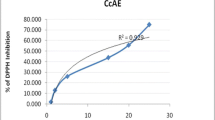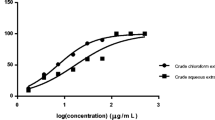Abstract
In this study, we investigated the effects of Ocimum basilicum essential oil on Giardia lamblia and on the modulation of the interaction of these parasites by peritoneal mouse macrophage. The essential oil (2 mg/ml) and its purified substances demonstrated antigiardial activity. Linalool (300 μg/ml), however, was able to kill 100% parasites after 1 h of incubation, which demonstrates its high antigiardial potential. Pretreatment of peritoneal mouse macrophages with 2 mg/ml essential oil dilution reduced in 79% the association index between these macrophages and G. lamblia, with a concomitant increase by 153% on nitric oxide production by the G. lamblia-ingested macrophages. The protein profiles and proteolitic activity of these parasite trophozoites, previously treated or not with 2 mg/ml essential oil or with the purified fractions, were also determined. After 1 and 2 h of incubation, proteins of lysates and culture supernatants revealed significant differences in bands patterns when compared to controls. Besides, the proteolitic activity, mainly of cysteine proteases, was clearly inhibited by the essential oil (2 mg/ml) and the purified linalool (300 μg/ml). These results suggest that, with G. lamblia, the essential oil from O. basilicum and its purified compounds, specially linalool, have a potent antimicrobial activity.






Similar content being viewed by others
References
Adam RD (2001) Biology of Giardia lamblia. Clin Microbiol 14:447–475
Adams RP (1995) Identification of essential oil components by gas chromatograpy/mass spectroscopy. Allured Publishing Corporation, Illinois, p 469
Barakiewicz J, Dosch H M, Cohen A (1988) Extracellular nucleotide catabolism in human B and T lynfocytes: the source of the adenosine production. J Biol Chem 263:7094–7098
Charles C, Simon JE (1992) A new geraniol chemothype of Ocimim gratissimum L. J Essent Oil Res 4:231–234
Conner DE, Beuchat LR (1984a) Sensitivity of heat-stressed yeast to essential oils of plants. Appl Environ Microbiol 47:229–233
Conner DE, Beuchat LR (1984b) Effects of essential oils from plants on growth of food spoilage yeast. J Food Sci 49:429–434
David J, Soares M, Satoskar A, Brombacher F, Shoemaker C, Titus R, Bozza M (1997) Immunomodulatory properties of maxadilan, a peptide derived from sand fly saliva. Acta Parasitol Turc 21:174
Davidson RA (2003) Treatment of giardiasis: the North American perspective. In: Meyer EA (ed) Human parasitic diseases, Giardiasis. Elsevier, Amsterdam, 1990, pp 325–334
Eckmann L (2003) Mucosal defences against Giardia. Parasite Immunol 25:259–270
Eckmann L, Laurent F, Langford TD, Hetsko ML, Smith JR, Kagnoff MF, Gillin FD (2000) Nitric oxide production by human epithelial intestinal cells and competition for arginine as potential determinants of host defense against the lumen-dwelling pathogen Giardia lamblia. J Immunol 164:1478–1487
Esquenazi D, Wigg MD, Miranda MMFS, Rodrigues HM, Tostes JBF, Rozental S, Silva AJR, Alviano CS (2002) Antimicrobial and antiviral activities of poliphenolics from Cocos nucifera Linn. (Palmae). Res Microbiol 153:647–652
Flanagan PA (1992) Giardia—diagnosis, clinical course and epidemiology. A review. Epidemiol Infect 109:1–22
Fraser D, Bilenko N, Deckelbaum RJ, Dagan R, el-On J, Naggan L (2000) Giardia lamblia carriage in Israeli Bedouin infants: risks factors and consequences. Clin Infect Dis 30:419–424
Friedman GD (1980) Cancer after metronidazole. N Engl J Med 302:519
Fung DYC, Taylor S, Kahan J (1977) Effects of butylated hydroxyanisole (BHA) and butylated hydroxitoluene (BHT) on growth and aflatoxin production of Aspergillus flavus. J Food Safety 1:39–51
Gantt KR, Goldman TL, McCornick ML, Miller MA, Jeronimo SMB, Nascimento ET, Britigan BE, Wilson ME (2001) Oxidative responses of human and murine macrophages during ohagocytosis of Leishmania chagasi. J Immunol 167:893–901
Green SJ, Meltzer MS, Hibbs JB, Nacy CA (1990) Activated macrophages destroy intracellular Leishmania major amastigotes by l-arginine-dependent killing mechanism. J Immunol 144:278–283
Guimarães S, Sogayar MITL, Franco MF (2003) Protease activity in Giárdia duodenalis trophozoites of axenic strains isolated from symptomatic and asymptomatic patients. Mem Inst Oswaldo Cruz 98:77–81
Harris JC, Plummer S, Turner MP, Lloyd D (2000) The microaerophilic flagellate Giardia intestinalis: Allium sativum (garlic) is an effective antigiardial. Microbiol 146:3119–3127
Hill DR, Pearson RD (1987) Ingestion of Giardia lamblia trophozoites by human mononuclear phagocytes. Infect Immun 55:3155–3161
Hill DR, Pohl R (1990) Ingestion of Giardia lamblia trophozoites by murine Payer’s patch macrophages. Infect Immun 58:3202–3207
Ignácio SRN, Ferreira JLP, Almeida MB, Kubelka CF (2001) Nityric oxide production by murine macrophages in vitro and in vivo treated with Phyllanthus tenellus extracts. J Ethnopharmacol 74:181–187
Koga T, Hirota N, Takumi K (1999) Bactericidal activities of essential oils of basil and sage against a range of bacteria and the effect of these essential oils on Vibrio parahaemolyticus. Microbiol Res 154:267–273
Labra M, Miele M, Ledda B, Grassi F, Mazzei M, Sala F (2004) Morphological characterization, essential oil composition and DNA genotyping of Ocimum basilicum L. cultivars. Plant Sci 167:725–731
Laemmli UK (1970) Cleavage of structural protein during the assembly of the bacteriophage T4. Nature 277:680–685
Lee SJ, Umano K, Shibamoto T, Lee KG (2005) Identification of volatile components in basil (Ocimum basilicum L.) and thyme leaves (Thymus vulgaris L.) and their antioxidant properties. Food Chem 91:131–137
Lopes AHC, Dutra SPML, Rodrigues CO, Soares MJ, Angluster J, Cordeiro RSB (1997) Effect of platelet-activating factor on the process of cellular differentiation of Herpetomonas muscarum muscarum. J Eukaryot Microbiol 44:321–325
Lowry OH, Rozebrough NJ, Farr AL, Randall RJ (1959) Protein measurement with the folin phenol reagent. J Biol Chem 193:265–275
Martins AP, Salgueiro LR, Vila R, Tomi F, Canigueral S, Casanova J, Proenca da Cunha A, Adzet T (1999) Composition of the essential oils of O. canum, O. gratissimum and O. minimum. Planta Med 65:187–189
Mendonça-Filho RR, Rodrigues IA, Alviano DS, Santos ALS, Soares RMA, Alviano CS, Lopes AHCS, Rosa MSS (2004) Leishmanicidal activity of poliphenolic-rich essential extract from husk fiber of Cocos nucifera Linn. (Palmae). Res Microbiol 155:136–143
Miele M, Pondero R, Ciarallo G, Mazzei M (2001) Methyl–eugenol in Ocimum basilicum L. cv Genovese gigante. J Agric Food Chem 49:517–521
Nash TE, Herrington DA, Losonsky GA, Levine MM (1987) Experimental human infections with Giardia lamblia. J Infect Dis 156:974–984
Ohashi ST, Rosa LS, Santana JA, Green CL (1997) Brazilian rosewood oil: sustainable production and oil quality management. Perf Flav 22:1–5
Owen RL, Allen CL, Stevens DP (1981) Phagocytosis of Giardia muris by macrophages in Peyer’s patch epithelium in mice. Infect Immun 33:591–601
Prozesky EA, Meyer JJM, Louw AI (2001) In vitro antiplasmodial activity and cytotoxity of sethonobotanically selected South African plants. J Ethnopharmacol 76:239–245
Roberts-Thomson IC, Stevens DP, Mahmoud AAF, Warren KS (1976) Acquired resistance to infection in an animal model of giardiasis. J Immunol 117:2036–2037
Simon JE, Morales MR, Phippen WB, Vieira RF, Hao Z (1999) A source of aroma compounds and a popular culinary and ornamental herb In: Janick J (ed) Perspectives on new crops and new uses. ASHS Press Alexandria, VA, pp 499–505
Van Den Dool H, Kratz PDJA (1963) Generalization of the retention index system including linear temperature programmed gas–liquid partition chromatography. J Chrom 11:463–471
Werker E, Putievsky E, Ravid U, Dudai N, Katzir I (1993) Glandular hairs and essential oil in developing leaves of Ocimim basilicum L. (Laminaceae). Ann Bot 71:43–50
WHO The World Health Report (2002) Fighting disease fostering development. World Health Organization, Geneva
Wray W, Boulikas T, Wray VP, Kancol JR (1981) Silver staining of proteins in polyacrylamide gels. Anal Biochem 118:197–203
Acknowledgments
We thank Ms. Camilla M. Fortunato and Ms. Simone S. dos Santos for technical support. This work was supported by Fundação de Amparo a Pesquisa no Estado do Rio de Janeiro (FAPERJ), Conselho Nacional de Desenvolvimento Científico e Tecnológico (CNPq), Fundação Universitária José Bonifácio (FUJB), and Coordenação de Aperfeiçoamento de Pessoal de Nível Superior (CAPES).
Author information
Authors and Affiliations
Corresponding author
Additional information
Igor de Almeida and Daniela Sales Alviano contributed equally to this study.
Rights and permissions
About this article
Cite this article
de Almeida, I., Alviano, D.S., Vieira, D.P. et al. Antigiardial activity of Ocimum basilicum essential oil. Parasitol Res 101, 443–452 (2007). https://doi.org/10.1007/s00436-007-0502-2
Received:
Accepted:
Published:
Issue Date:
DOI: https://doi.org/10.1007/s00436-007-0502-2




